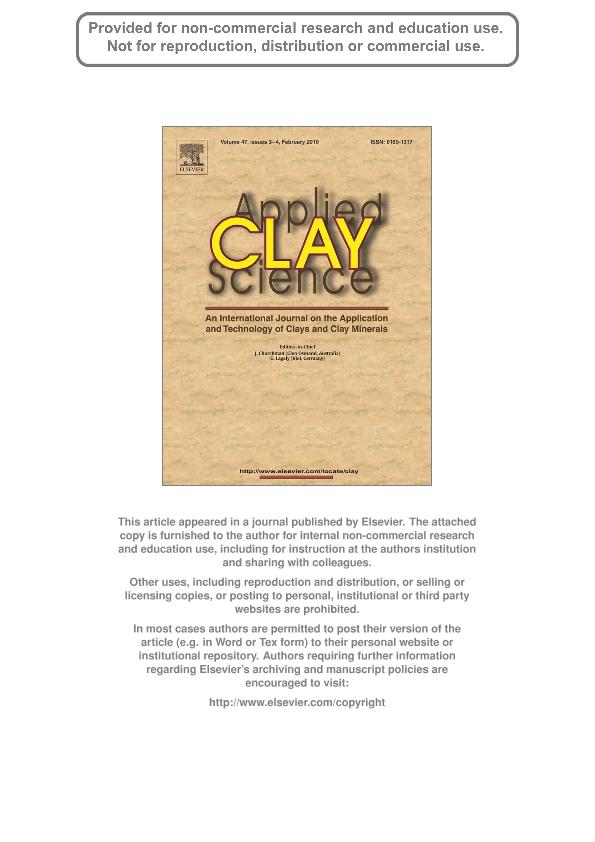Mostrar el registro sencillo del ítem
dc.contributor.author
Dominguez, Eduardo Alejandro

dc.contributor.author
Iglesias, Iglesias
dc.contributor.author
Dondi, Michele
dc.contributor.author
Murray, Haydn
dc.date.available
2019-04-04T20:04:54Z
dc.date.issued
2010-02
dc.identifier.citation
Dominguez, Eduardo Alejandro; Iglesias, Iglesias; Dondi, Michele; Murray, Haydn; Genesis of the La Espingarda kaolin deposit in Patagonia; Elsevier Science; Applied Clay Science; 47; 3-4; 2-2010; 290-302
dc.identifier.issn
0169-1317
dc.identifier.uri
http://hdl.handle.net/11336/73212
dc.description.abstract
The La Espingarda kaolin deposit was formed by "in situ" alteration of sub-alkaline rhyolites belonging to the Jurassic Marifil Formation. Three altered volcanic lithofacies were identified: a porphyric biotitic ignimbrite (RPB), a coarse lithic ignimbrite (ILG), and a fluidal intrusive rhyolite (RFI). The kaolinization covers an ellipsoidal surface area of ∼ 20,000 m2, with the alteration intensity decreasing downwards and disappearing at 8-12 m from the surface. In two mine sectors small stockworks of fine quartz veins appears (< 3 m2). The deepest alteration is related to two fault zones where the three volcanic units are in contact. There is no lateral clay zoning at the faults. The mineralogical composition is kaolinite ± halloysite ± illite + quartz + feldspars + Fe-hydr(oxides). At least three kaolinite generations were identified. The first is pervasive; the second appears as a filling of vugs in the quartz veinlets that crosscut the pervasively altered rocks; and the third occurs as pure kaolin veins without quartz vein cross cuts. During the alteration processes almost total alkali cations were leached. The argillized lithofacies showed Ni enrichment and Cu, Sr, and Ba depletions. The main weathering genesis for La Espingarda is supported by the deposit morphology, its location in topographic lows, the paleoclimatic record, its simple mineralogical composition; vertical zonation, the kaolinite veins isotopes (δ18O ‰ 18.3; δD ‰ - 59.0), and the trace element distribution. A steam heated water activity produced some kaolinite overprint according to one isotopic value and the S and P contents slightly higher in the kaolinized rocks. Neither Au, Ag, As, Sb, Hg, or Ba epithermal pathfinders' anomalies nor drill data support the existence of any metallic mineralization at the kaolin blanket bottom. In Patagonia hydrothermal kaolinite manifestations are located around and beneath silicified, erosion-resistant hills and include some of the following minerals: dickite, alunite, pyrophyllite, or pyrite and have As, S, Ba, and Ag trace elements within the range of weak geochemical anomalies.
dc.format
application/pdf
dc.language.iso
eng
dc.publisher
Elsevier Science

dc.rights
info:eu-repo/semantics/openAccess
dc.rights.uri
https://creativecommons.org/licenses/by-nc-sa/2.5/ar/
dc.subject
Epithermal
dc.subject
Exploration
dc.subject
Genesis
dc.subject
Kaolin
dc.subject.classification
Meteorología y Ciencias Atmosféricas

dc.subject.classification
Ciencias de la Tierra y relacionadas con el Medio Ambiente

dc.subject.classification
CIENCIAS NATURALES Y EXACTAS

dc.title
Genesis of the La Espingarda kaolin deposit in Patagonia
dc.type
info:eu-repo/semantics/article
dc.type
info:ar-repo/semantics/artículo
dc.type
info:eu-repo/semantics/publishedVersion
dc.date.updated
2019-03-08T20:18:49Z
dc.journal.volume
47
dc.journal.number
3-4
dc.journal.pagination
290-302
dc.journal.pais
Países Bajos

dc.journal.ciudad
Amsterdam
dc.description.fil
Fil: Dominguez, Eduardo Alejandro. Consejo Nacional de Investigaciones Científicas y Técnicas. Centro Científico Tecnológico Conicet - Bahía Blanca. Instituto Geológico del Sur. Universidad Nacional del Sur. Departamento de Geología. Instituto Geológico del Sur; Argentina
dc.description.fil
Fil: Iglesias, Iglesias. Piedra Grande Sa; Argentina
dc.description.fil
Fil: Dondi, Michele. CNR-ISTEC. Istituto di Scienza e Tecnologia dei Materiali Ceramici; Italia
dc.description.fil
Fil: Murray, Haydn. Indiana University; Estados Unidos
dc.journal.title
Applied Clay Science

dc.relation.alternativeid
info:eu-repo/semantics/altIdentifier/url/https://www.sciencedirect.com/science/article/pii/S0169131709003263
dc.relation.alternativeid
info:eu-repo/semantics/altIdentifier/doi/https://doi.org/10.1016/j.clay.2009.11.030
Archivos asociados
